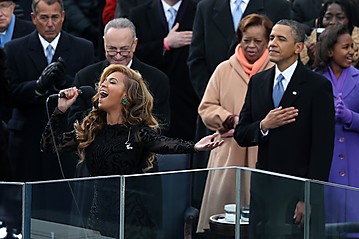Last week in class the topic of
online debates was brought up. Many people brought forth very interesting examples
of online debates relating to politics, gender discrimination, entertainment
and other such topics.
One online debate that was circulating
for a while and got me particularly heated in class was the question of whether
famed singer Beyoncé Knowles lip-synced her
performance
at the presidential inauguration ceremony on January 22,
, 2013. As
it turned out the singer, known for powerful pipes, did admit to lip-syncing at
a press conference, but not before showing the world that just because she lip-
synced didn’t mean she couldn’t do the exact
same performance live. She began the
press
conference by singing the national anthem loud and proud and later explained
the reasoning behind the decision to lip-sync at the inauguration was due to
technicalities and lack of rehearsals, which made her uncomfortable doing the
performance live.
Just a few weeks later the star
burned the stage up and caused a power outage during her Superbowl halftime
performance. Audiences around the world were in awe by her post-baby body and
incredible LIVE
performance.
Talk of her inauguration performance has died down, however, in the heat of it
all I can say that the debates around Facebook and online blogs were quite
intense. I can admit that I participated in some civil debates over Facebook as
well.

However, in stepping back and
analyzing the topic of online debates such as these via the comments on blogs
or on social networking cites, it simply goes to show how incredibly rapidly
information goes viral and how every individual who wants to, can give their
opinion. No matter how informed or uninformed one is on a topic, everyone in
this online public sphere has a voice. One’s post may be read by only two
people or it may be read by thousands, but chances are someone at some point
stumbles across it. Moreover, no one can technically silence anyone. Everyone
is essentially equal. Obviously there are those people with more followers on
their blogs or on twitter, and those more prominent opinion leaders in the
community (some might refer to bloggers like
Perez
Hilton for that- personally I wouldn’t, but just as an example since the
number of people that follow him is massive), who will always have a greater
impact on society as a whole, but, regardless, each and every single online
contributor (via youtube, blogs, twitter, etc. …) has a voice that can get
heard, despite the number that hear it. Personally, I think this is one of the
greatest benefits of the Internet itself and Mr. Habermas would likely agree
with me on this statement.
The prominent artist and thinker Andy Worhol said it right…
“In the future everyone will be world-famous for 15 minutes.”
Welcome to the future.
 Anyone who has ever said they cannot dance should be eating their words because when I see the hundreds or thousands of people that take part in viral dance videos online I know that there ARE moves simple enough for anyone to learn and fun enough to make everyone get up and dance! From Gagnum Style , to the Dougie , to the Harlem Shake (which I still don't technically consider a real dance), these videos have gone viral for a reason, and that is because everyone can join in the fun of doing them. What a great ice breaker and way to feel connected to people on the dance floor or around the world!
Anyone who has ever said they cannot dance should be eating their words because when I see the hundreds or thousands of people that take part in viral dance videos online I know that there ARE moves simple enough for anyone to learn and fun enough to make everyone get up and dance! From Gagnum Style , to the Dougie , to the Harlem Shake (which I still don't technically consider a real dance), these videos have gone viral for a reason, and that is because everyone can join in the fun of doing them. What a great ice breaker and way to feel connected to people on the dance floor or around the world!








